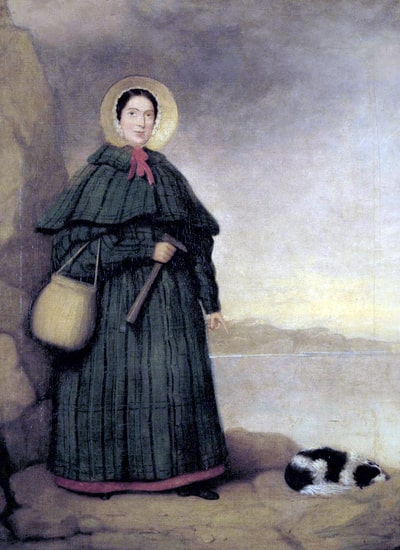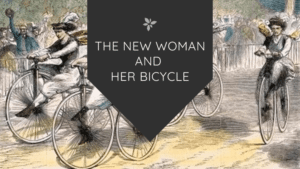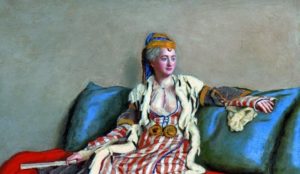Born in a time when misogyny and Georgian masculinity was rampant, little Mary Anning contributed extraordinary discoveries to the scientific world. Unfortunately, during her time, and after, Mary never got credit where credit was due. Although society is only just started to catch up on attributing her work, Mary Anning is now known as a pioneer in fossil collecting and discovery; setting the course for British paleontology as we know it today.

In 1799, Mary Anning was born to a very low-income family in Lyme Regis, Dorset, England. Mary and her brother Joseph were the only children of nine or ten to survive until adulthood. To further attribute her extraordinary life, at just 15 months, Mary survived a lightning strike that killed three women, included the one holding her.
When struggling to bring money in, her father took to fossil collecting on what we now call the Jurassic Coast. He brought along Mary, aged 5, to help him in his hunt.
During a time when girls were not encouraged in their formal education, Mary taught herself geology and anatomy through her work as a fossil finder with her father. To supplement the income that never seemed to be there, her father and Mary would clean, polish and sell these fossils to tourists visiting the area.
After her father died in 1810, her brother went to work as an apprentice, and Mary continued finding and selling her fossils to supplement income for the household. Joseph would often join Mary in her hunt for fossils.
Only a year after her father’s death, in 1811, Mary and Joseph discovered the fossilized skull of an ichthyosaur. It took months of painstaking uncovering work for Mary to dig out the remaining 17-foot long skeleton, but she succeeded. Sold for £23 (about £2200 in today’s money), this skeleton still sits at London’s Natural History Museum.
This incredible discovery came at a time when the theory of extinction was only just making waves in the world of science. During this time, Cabinets of Curiosities were flourishing in Georgian England and tourists were flocking to the coasts. Due to frequent discoveries, society’s interest in fossils was constantly being fueled by new finds. Even museums were struggling to keep up with the demand for fossil displays.
Mary’s next ‘big’ discovery wouldn’t be until 1823 when she uncovered the complete skeleton of a Plesiosaurus – a 9-foot swimming reptile – a specimen that had never been discovered before. This find is said to be her most important scientific find.
In 1828 Mary uncovered a pterosaur (later called a Pterodactyl), which was the first one discovered outside of Germany. Mary also spearheaded the study of coprolites or fossilized poop.
Mary easily sold many of her fossil finds, however, she and her family still endured monetary hardships throughout her life.
Although Mary was known to have discovered significant geological funds, she never got the recognition she so justly deserved in this Georgian age. Being a woman in science, Mary was never given proper reference to her discoveries.
In 1824, Lady Harriet Sivester, met Mary and wrote in her own diary,
. . . the extraordinary thing in this young woman is that she has made herself so thoroughly acquainted with the science that the moment she finds any bones she knows to what tribe they belong. She fixes the bones on a frame with cement and then makes drawings and has them engraved. . . It is certainly a wonderful instance of divine favour – that this poor, ignorant girl should be so blessed, for by reading and application she has arrived to that degree of knowledge as to be in the habit of writing and talking with professors and other clever men on the subject, and they all acknowledge that she understands more of the science than anyone else in this kingdom.
Lady Harriet Sivester
Scientists from all over would visit Mary in Lyme Regis and examine the fossils she had found, but never did they credit her with the discovery. She is known to have said,
The world has used me so unkindly, I fear it has made me suspicious of everyone.
Mary Anning
While her discoveries were world-renowned, Mary reaped little (if any) monetary reward or notoriety for her hard work. In 1826, Mary and her mother opened a fossil shop in Lyme Regis to bring in income.
In 1838, after being pressured by one of her male scientist peers – who appreciated her work in the development of paleontology – Mary was granted an annual income from the British Association for the Advancement of Science and London’s Geological Society to continue her fossil-finding work. While this was a meager sum, it helped support Mary and her mother until her death at the age of 47 in 1847. Throughout her lifetime of incredible scientific discoveries, she never stopped in her search for fossils and contributing to the scientific world.
At a time when the world was opening up to the age of extinction theories, Mary’s fossil-hunting endeavors and her fossil-selling profession fueled public interest in fossils, geology, and paleontology. Her work in science were important contributors to the understanding of the world’s life and history.
Next, read about Gertrude Bell, Al Khatun: Queen of the Desert, an adventurer, spy, archaeologist and powerful political force who travelled into the uncharted Arabian desert and was recruited by British Military Intelligence to help reshape the Middle East after World War I!
Ashley Winder has been Freelance Writing for clients who have forgone the written word for over 3 years. She provides ghostwritten columns, content writing, and blog editing services. Her educational background in museums and art galleries have given her a strong base from which to approach many cultural, historical and artistic topics. As a Contributing editor at Mainly Museums and a resident blog contributor at Girl Museum, Inc, Ashley has kept alive her work in museums and history whilst simultaneously pursuing her passion of traveling the globe.





Female Fossil Finder has to be the best headline I have read all day. I predict a trip to the library to find out more about Mary Anning soon!